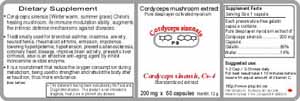
A highly regarded Chinese formula based on
Cordycep is known as "Gold & Water Treasure".
Gold in TCM is lung, water is kidney; Hence in TCM Cordyceps is used
mainly for lung and kidney problems.
In TCM Cordyceps
is used to relief of bronchial inflammation; treatment of chronic bronchitis; insomnia,
hypertension, pneumonia; pulmonary emphysema and tuberculosis; relief of
exhaustion or tiredness; debility following illness; anemia; night
sweats; chronic nephritis; impotence and seminal emissions.
Cordyceps has properties similar to ginseng,
being used to strengthen and rebuild the body after exhaustion. It is
highly regarded for restoring vitality.
Cordyceps contains all types of nucleosides used in gene
regeneration or repairs. It is a
building block for DNA repair and gene correction in cell replication.
It plays an important role in ATP,c- AMP (energy) metabolism.
DNA & RNA are formed by
long chains of polynucleotides, which are composed of millions of
nucleosides. Therefore the effect of supplying "ready to use
building blocks" is absolutely vital.
|
Recommended dosage:
Anti-aging preventative:
- 1- 2 capsules each time, two to three times per day.
Therapeutic:
- Mycelia extract 4-8 capsules per day, divided into three
times.
Contraindication:
- Allergic to any of the above ingredient.
Reported biological activities of cordycepin include:
- (a) Inhibits the production of DNA and RNA
synthesis in cancer cells. (Plageman and Erabe, 1971);
- (b) enhancement of cell differentiation (Mathew et
al., 1989);
- (c) restructuring of cytoskeleton in cells (Deitchand,
1979, Zieve and Roemer, 1988);
- (d) inhibition of protein kinase activity (Glazer
and Juo, 1977);
- (e) antitumor activity on bladder, kidney, colon,
lung carcinoma as well as fibroblastoma (Hubell et al., 1985);
- (f) inhibition of the infection and reverse
transcriptase activity of human immunodeficiency virus type I (Montefiori
et al., 1989; Muller et al., 1991)
- (g) inhibition of methylation of nucleic acid (Noval-fernandez
and Leory, 1980); and
- (h) inhibition of chemotaxis and specific proteins
synthesis of the macrophage cell line (Aksamit et al., 1983).
More clinical studies
|